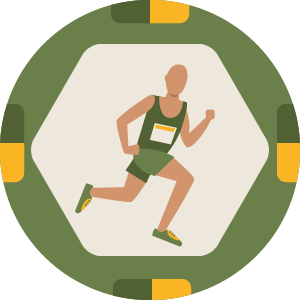
-
4,278,374Chips
-
8,767Rank
-
highStake Level
-
48 - Dirty HarryRPP Level
About Me
Thanks for checking out my profile! Here's a practical guide on beating maniacs. I'm not posting this in the forum, because they're easy money for me, and we don't want to drive the maniacs extinct by overhunting, do we?
Exercise 1: Doubling Up.
For your first exercise, we'll keep it simple, but not having to worry about postflop play.
Find a Maniac. We need a maniac to make this exercise work. Go to "Ring Games", and find a table with very high average pot to blind ratio (50x+). You'll usually find a maniac there.
Buy in small. Buy in at the table minimum, which will be 50 BB (this is a bankroll for the shoving we're about to do). You can sit out for a few hands, while we work on the next step.
Identify the Maniac. You're looking for someone who's bet/raising 30+% of hands to a big size, perhaps 10BB+.
Bingo time. Against the maniac, you want to fold the vast majority of hands, and shove with premium holdings. You can use either a polarized or merged range, but I generally prefer a merged range, because the table will often have calling stations, which is why the maniac is being a maniac in the first place.
If you shove the maniac with suited connectors, you risk the maniac folding, but some calling station call with garbage like K6, which has good equity against you.
Here's a sample 9% merged range to get you started:
AJo+, 66+, KJs, KQs, A9s+Leave the table once you double up.
Now, your stack is 100+ BB, which makes the bingo strategy worse. In addition, the maniac is now aware of your presence and will adapt accordingly. (Nothing scares a maniac like someone who folds a few times, then shoves and shows a premium hand.)
The topic of what to do when the maniac adapts, postflop play against a maniac (a necessity once you get bigger stacks / maniac sizes down, and thus you can't shove preflop), and how to protect your limping range when playing before a maniac is a topic for another guide.
For the people complaining about maniacs, this shove/fold exercise should be enough to get them to calm down or leave the table.
-- WIP --
Maniac Responses:
Generally speaking, the Maniac adapting to your play will happen immediately, and the difference will be dramatic. You will see much less frequent aggression frequency, and much smaller sizing.
Keep an eye on when they make their big bets. If they only make big bets when you're already out of the pot, that means they fear you! Good job!
If they suddenly make a big bet while you're still later to act, that means they have a monster, and you should tighten your range accordingly. AK, JJ+ is the type of range you need for this.
Acting Before a Maniac:
Once a maniac fears you, they will generally steer clear of you. That means folding after you raise, and raising after you fold. This presents a problem with a limping. Normally, you limp (after another limper) with a drawing hand, such as suited connectors. With a strong hand, such as AQo, it's more profitable to squeeze. The problem is that this leaves your limping range unprotected from being squeezed. Normally, this isn't an issue, because the calling stations protect you from someone squeezing too widely, but in the case of a maniac, the only person they fear is you.
The solution is to sacrifice a single premium hand that you would otherwise squeeze with, and instead limp. I do not condone open limping, but with a maniac after me to act, I make an exception - they will interpret the limp as a sign of weakness, and you can give 'em the good ol' shove.
Once you've trapped a maniac once this way, you should play normally from then on. They won't fall for it again, which was your goal anyways, because now your limping range is protected from the maniac.
How to Tilt a Maniac:
Follow the steps above to get the maniac to fear you.
Wait until you're after the maniac to act, and you have a garbage hand.
Tell the maniac to bet big. They will likely fold.
Fold when it's your turn. (You have a garbage hand, you should fold.)
The maniac may leave the table shortly after that.
Postflop Play:
To understand postflop play, you should look at how the maniac is used to making money.
1. Play a 40% range, betting big to 12 BB.
2. Wait for the calling stations to call.
3. When the flop comes, c-bet big (half pot), whether you have anything or not.
4. Easy money if they fold. If they raise, then they clearly have something, so get out of the way unless you have something.
This creates a problem for you. If the flop comes K63, and the maniac c-bets, they could have:
KJo
Q6s
JTo
It's hard to put them on a range, which is why I like fighting maniacs preflop.
Here's some tips:
- If you're out of position, check to them. This is standard play against any preflop aggressor, and it's more true against maniacs.
- Call more loosely. If they're betting anything, then mid pair is maybe good enough, and if not, it has a chance of improving! Even two overcards might be good enough. After all, there's a chance they're betting with nothing, in which case your nothing is better than their nothing.
- Raise them with a balanced range. Extract value from your value hands, and at the same time, balance your range with semi-bluffs. Hands like flush draws and 2 overcards have equity against their top pairs.
- Note that, if you're a TAG, and you're in a flop against a maniac (as a cold-caller or a 4-bettor who got called), your range is stronger than theirs! That means you should act more aggressively on a big board like AQ7, and more passively on a board like 984. This is even more true if there's any calling stations in the pot. In addition to betting more frequently on big boards, you should also size smaller. This is because the maniac knows they are drawing dead against an ace pair, and thus a smaller bet size is enough to fold them out. This is standard pre-flop aggressor stuff, and if the maniac is paying attention, they should be the one checking to you.
- Identify the type of maniac. Some maniacs will barrel all 3 streets with air, and some maniacs will bluff on the flop, but stop after getting called. (If the maniac fears you, it's likely they are the later type.) This should affect your play. Against a 1-barrel maniac, calling on the flop becomes more attractive with a speculative hand, while in position, since that means you'll likely see two cards, and you can even bluff them back after they check to you on the turn.
- Against a multi-barrel maniac, with a very strong hand (such as a set), you can call on the flop, and check-raise on the turn to extract more value. Mind the texture of the board though - if it looks something like 468, you need to fold them out on the flop to stop them from improving. (Also, it balances your own semi-bluff range with your own straight draws.)
Funniest Squeeze Ever: #1033403854
Ring Game Hands
View latest HandsEndorsements Rank: 1
Reward good play and behavior




